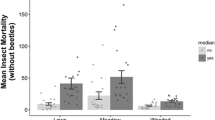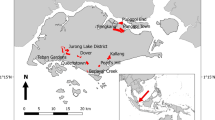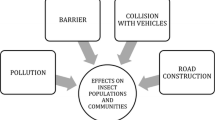Abstract
Whereas roads that bisect habitat are known to decrease population size through animal-vehicle collisions or interruption of key life history events, it is not always obvious how to reduce such impacts, especially for flying organisms. We needed a quick, cost-efficient and effective way to determine how best to decrease vehicle-caused mortality while maintaining habitat connectivity for the federally listed Oregon silverspot butterfly, Speyeria zerene hippolyta. Therefore, we gathered targeted ecological information that informed selection of a mitigation option prior to implementation. We sampled butterfly behavior and environmental conditions along a highway and conducted a small-scale experiment along a decommissioned road corridor used by these butterflies. Using our findings, we recommended vegetation management and helped managers eliminate options they were considering that would be ineffective such as increasing shade or wind in the road, and installing fencing or hedgerows aimed at directing flight above traffic. This quick and inexpensive approach of using ecological observations and small-scale experiments to evaluate the likely success of each available mitigation option can be used to determine effective, species-specific solutions for reducing traffic impacts on pollinators and other small, flying organisms of conservation concern.


Similar content being viewed by others
References
Arnold RA (1998) Ecological and behavioral studies on the threatened Oregon silverspot butterfly at its Rock Creek, Cascade Head, Mt. Hebo, and Clatsop Plains populations in Oregon. U.S. Department of Interior, Fish and Wildlife Service, Olympia
Baxter-Gilbert JH, Riley JL, Neufeld CJ, Litzgus JD, Lesbarrères D (2015) Road mortality potentially responsible for billions of pollinating insect deaths annually. J Insect Conserv 19:1029–1035
Bennett VJ (2010) Addressing the primary threats that jeopardize the last remaining Oregon silverspot butterfly (Speyeria zerene hippolyta) populations. Future for Wildlife Grant Program, Oregon Zoo, Portland
Bhattacharya M, Primack RB, Gerwein J (2003) Are roads and railroads barriers to bumblebee movement in a temperate suburban conservation area? Biol Conserv 109:37–45
Bissonette JA et al. (2007) Wildlife and roads, decision guide. http://www.wildlifeandroads.org/decisionguide/2_1_1.cfm. Accessed 3 Feb 2010.
Clark RW, Brown WS, Stechert R, Zamudio KR (2010) Roads, interrupted dispersal, and genetic diversity in timber rattlesnakes. Conserv Biol 24:1059–1069. doi:10.1111/j.1523-1739.2009.01439.x
Conover MR, Pitt WC, Kessler KK, DuBow TJ, Sanborn WA (1995) Review of human injuries, illnesses and economic losses caused by wildlife in the U.S. Wildl Soc Bull 23:407–414
Czech B, Krausman PR, Devers PK (2000) Economic associations among causes of species endangerment in the United States: associations among causes of species endangerment in the United States reflect the integration of economic sectors, supporting the theory and evidence that economic growth proceeds at the competitive exclusion of nonhuman species in the aggregate. Bioscience 50:593–601
Dennis RLH (2008) Roadways: a burial ground for dead butterflies, or the flip-side to using tarmac as a substrate for thermoregulation and territorial perching? Entomol Gaz 59:172–173
Erritzoe J, Mazgajski TD, Rejt L (2003) Bird casualties on European roads-a review. Acta Ornithologica 38:77–93
Fahrig L, Rytwinski T (2009) Effects of roads on animal abundance: an empirical review and synthesis. Ecol Soc 14:21
Furness AN, Soluk DA (2015) The potential of diversion structures to reduce roadway mortality of the endangered Hine’s emerald dragonfly (Somatochlora hineana). J Insect Conserv 19:449–455
Gibbs JP, Shriver WG (2002) Estimating the effects of road mortality on turtle populations. Conserv Biol 16:1647–1652. doi:10.1046/j.1523-1739.2002.01215.x
Gotelli NJ, Ellison AM (2004) A primer of ecological statistics, 1st edn. Sinauer, Sunderland
Grilo C et al. (2012) Individual spatial responses towards roads: implications for mortality risk. PloS One 7:e43811
Grilo C, Reto D, Filipe J, Ascensão F, Revilla E (2014) Understanding the mechanisms behind road effects: linking occurrence with road mortality in owls. Anim Conserv 17:555–564
Hammond PC (2013) The 2013 report of Oregon silverspot butterfly response of native meadow habitat on the Siuslaw National Forest.
Haughton AJ et al. (2003) Invertebrate responses to the management of genetically modified herbicide-tolerant and conventional spring crops. II. Within-field epigeal and aerial arthropods. Phil Trans R Soc Lond B 358:1863–1877
Holderegger R, Di Giulio M (2010) The genetic effects of roads: a review of empirical evidence. Basic Appl Ecol 11:522–531 doi:10.1016/j.baae.2010.06.006
Huijser MP, Duffield JW, Clevenger AP, Ament RJ, McGowen PT (2009) Cost–benefit analyses of mitigation measures aimed at reducing collisions with large ungulates in the United States and Canada; a decision support tool. Ecol Soc 14:15
Humbert JY, Ghazoul J, Sauter G, Walter T (2010) Impact of different meadow mowing techniques on field invertebrates. J Appl Entomol 134:592–599
Jackson SD, Griffin CR (2000) A strategy for mitigating highway impacts on wildlife. In: Messmer TA, West B (eds) Wildlife and highways: seeking solutions to an ecological and socio-economic dilemma. The Wildlife Society, Bethesda, pp 143–159
Jones DN, Pickvance J (2013) Forest birds use vegetated fauna overpass to cross multi-lane road. Oecologia Aust 17:147–156
Karraker NE, Gibbs JP (2011) Contrasting road effect signals in reproduction of long-versus short-lived amphibians. Hydrobiologia 664:213–218. doi:10.1007/s10750-010-0592-1
Keret N, Välimäki P, Mutanen M, Shanas U (2015) Large roads disrupt insect movement: a case study of the Spodoptera littoralis (Lepidoptera: Noctuidae). J Insect Behav 28:544–554
Kociolek AV, Clevenger AP, Clair CCS, Proppe DS (2011) Effects of road networks on bird populations. Conserv Biol 25:241–249. doi:10.1111/j.1523-1739.2010.01635.x
Lampe U, Reinhold K, Schmoll T (2014) How grasshoppers respond to road noise: developmental plasticity and population differentiation in acoustic signaling. Funct Ecol 28:660–668
Lehner PN (1996) Handbook of ethological methods, 2nd edn. Cambridge University Press, Cambridge
Mader HJ (1984) Animal habitat isolation by roads and agricultural fields. Biol Conserv 29:81–96
Marsh DM, Jaeger JAG (2015) Direct effects of roads on small animal populations. In: Andrews KM, Nanjappa P, Riley SPD (eds) Roads and ecological infrastructure: concepts and applications for small animals. Johns Hopkins University Press, Baltimore, pp 42–56
Massemin S, Zorn T (1998) Highway mortality of barn owls in northeastern France. J Raptor Res 32:229–232
McGregor RL, Bender DJ, Fahrig L (2008) Do small mammals avoid roads because of the traffic? J Appl Ecol 45:117–123
McKenna DD, McKenna KM, Malcom SB (2001) Mortality of Lepidoptera along roadways in central Illinois. J Lepidopterists’ Soc 55:63–68
Mumme RL, Schoech SJ, Woolfenden GE, Fitzpatrick JW (2000) Life and death in the fast lane: demographic consequences of road mortality in the Florida Scrub-Jay. Conserv Biol 14:501–512
Munguira ML, Thomas JA (1992) Use of road verges by butterfly and burnet populations, and the effect of roads on adult dispersal and mortality. J Appl Ecol 29:316–329
Noordijk J, Delille K, Schaffers AP, Sykora KV (2009) Optimizing grassland management for flower-visiting insects in roadside verges. Biol Conserv 142:2097–2103
Ojeda VS, Trejo AR, Seijas S, Chazarreta L (2015) Highway network expansion in Andean Patagonia: a warning notice from Rufous-legged Owls. J Rapt Res 49:201–209
Orlowski G (2008) Roadside hedgerows and trees as factors increasing road mortality of birds: implications for management of roadside vegetation in rural landscapes. Landsc Urban Plan 86:153–161. doi:10.1016/j.landurbplan.2008.02.003
Patrick DA, Gibbs JP (2010) Population structure and movements of freshwater turtles across a road-density gradient. Landsc Ecol 25:791–801. doi:10.1007/s10980-010-9459-0
Patterson M (2009) Oregon Silverspot Fritillary Population Monitoring 2009 Flight Season. Annual Report to U.S. Fish and Wildlife Service On cooperative agreement #13420-8-J806. U.S. Fish and Wildlife Service
Powers R (1988) Revised biological assessment on the effect of Big Creek Bridge Replacement, U.S. 101, Oregon Coast Highway, Lane County, Oregon, on the Oregon Silverspot Butterfly (Speyeria zerene hippolyta). ODOT, Salem
Pryke SR, Samways MJ (2001) Width of grassland linkages for the conservation of butterflies in South African afforested areas. Biol Conserv 101:85–96
Rao RSP, Girish MKS (2007) Road kills: Assessing insect casualties using flagship taxon. Curr Sci 92:830–837
Ries L, Debinski DM, Wieland ML (2001) Conservation value of roadside prairie restoration to butterfly communities. Conserv Biol 15:401–411
Romin LA, Bissonette JA (1996) Deer-vehicle collisions: status of state monitoring activities and mitigation efforts. Wildl Soc Bull 24:276–283
Ruiz-Capillas P, Mata C, Malo JE (2013) Road verges are refuges for small mammal populations in extensively managed Mediterranean landscapes. Biol Conserv 158:223–229
Saarinen K, Valtonen A, Jantunen J, Saarnio S (2005) Butterflies and diurnal moths along road verges: does road type affect diversity and abundance? Biol Conserv 123:403–412
Sawaya MA, Clevenger AP, Kalinowski ST (2013) Demographic connectivity for ursid populations at wildlife crossing structures in Banff National Park. Conserv Biol 27:721–730. doi:10.1111/cobi.12075
Severns PM (2008) Road crossing behavior of an endangered grassland butterfly, Icaricia icarioides fenderi macy (Lycaenidae), between a subdivided population. J Lepid Soc 62:53–56
Shine R, Lemaster M, Wall M, Langkilde T, Mason R (2004) Why did the snake cross the road? Effects of roads on movement and location of mates by garter snakes (Thamnophis sirtalis parietalis). Ecol Soc 9:9
Skórka P, Lenda M, Moroń D, Kalarus K, Tryjanowski P (2013) Factors affecting road mortality and the suitability of road verges for butterflies. Biol Conserv 159:148–157
Soanes K, Lobo MC, Vesk PA, McCarthy MA, Moore JL, Van Der Ree R (2013) Movement re-established but not restored: inferring the effectiveness of road-crossing mitigation for a gliding mammal by monitoring use. Biol Conserv 159:434–441
Soderstrom B, Hedblom M (2007) Comparing movement of four butterfly species in experimental grassland strips. J Insect Conserv 11:333–342. doi:10.1007/s10841-006-9046-5
Soluk DA, Moss K (2003) Roadway and exuvial surveys of the Hine’s emerald dragonfly (Somatochlora hineana) in Door County, Wisconsin. Part II: Roadway fatalities. Natural History Survey. Center for Aquatic Ecology Report.
Soluk DA, Zercher DS, Worthington AM (2011) Influence of roadways on patterns of mortality and flight behavior of adult dragonflies near wetland areas. Biol Conserv 144:1638–1643
Sullivan TL, Williams AF, Messmer TA, Hellinga LA, Kyrychenko SY (2004) Effectiveness of temporary warning signs in reducing deer-vehicle collisions during mule deer migrations. Wildl Soc Bull 32:907–915
Teixeira FZ, Printes RC, Fagundes JCG, Alonso AC, Kindel A (2013) Canopy bridges as road overpasses for wildlife in urban fragmented landscapes. Biota Neotropica 13:117–123
Testa N (1995) Biological Assessment on the effects of the Big Creek Bridge Rehabilitation, Lincoln County, Oregon on the Oregon Silverspot Butterfly (Speyeria zerene hippolyta). Oregon Department of Transportation, Salem
U.S. Fish and Wildlife Service (2001) Oregon silverspot butterfly (Speyeria zerene hippolyta) revised recovery plan. U.S. Fish and Wildlife Service, Portland
Valtonen A, Jantunen J, Saarinen K (2006) Flora and lepidoptera fauna adversely affected by invasive Lupinus polyphyllus along road verges. Biol Conserv 133:389–396. doi:10.1016/j.biocon.2006.06.015
Valtonen A, Saarinen K, Jantunen J (2007) Intersection reservations as habitats for meadow butterflies and diurnal moths: guidelines for planning and management. Landsc Urban Plan 79:201–209. doi:10.1016/j.landurbplan.2005.09.003
Wynhoff I, van Gestel R, van Swaay C, van Langevelde F (2011) Not only the butterflies: managing ants on road verges to benefit Phengaris (Maculinea) butterflies. J Insect Conserv 15:189–206. doi:10.1007/s10841-010-9337-8
Acknowledgments
We thank Martin Bray, Paul Hammond, Randy Miller, Mike Patterson, Melissa Shelley, Paul G. Thomas, and Anne Walker for their generous support and expertise and Chris Parker and Patrick Edwards for help with statistical analyses. Portland State University funded the project (FEA grant to CED) and the USDA Forest Service provided housing as well as field support.
Author information
Authors and Affiliations
Corresponding author
Electronic supplementary material
Below is the link to the electronic supplementary material.
Rights and permissions
About this article
Cite this article
Zielin, S.B., Littlejohn, J., de Rivera, C.E. et al. Ecological investigations to select mitigation options to reduce vehicle-caused mortality of a threatened butterfly. J Insect Conserv 20, 845–854 (2016). https://doi.org/10.1007/s10841-016-9916-4
Received:
Accepted:
Published:
Issue Date:
DOI: https://doi.org/10.1007/s10841-016-9916-4




